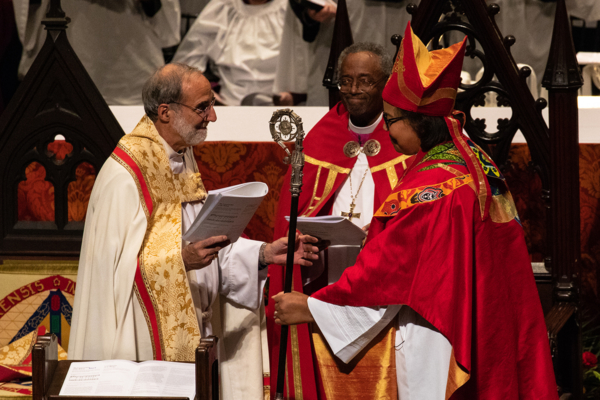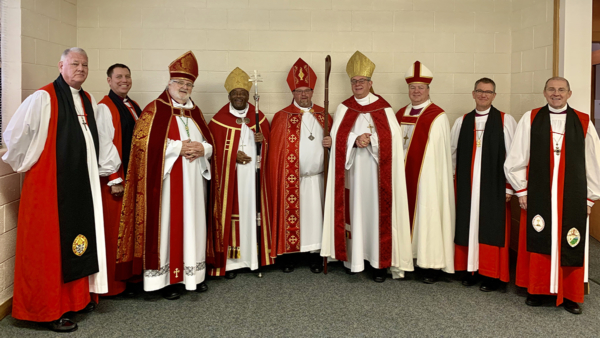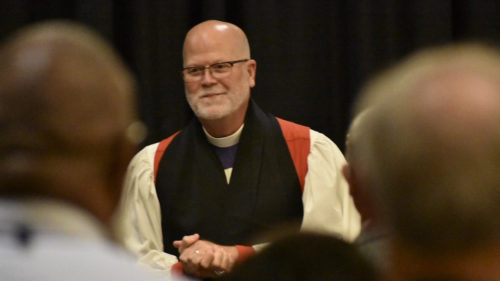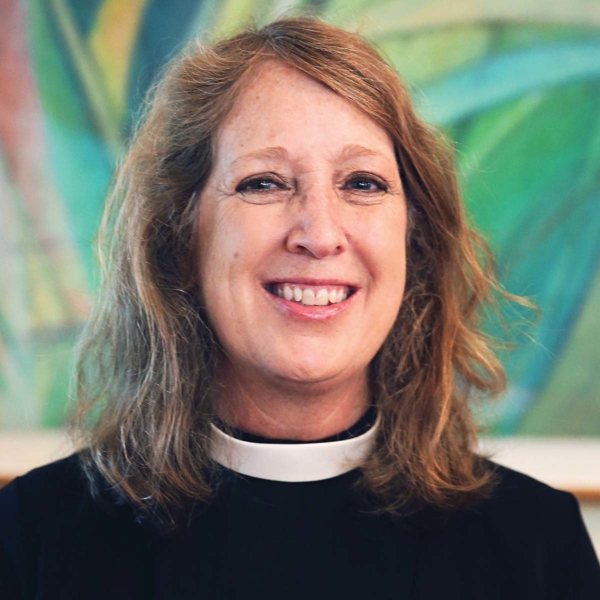Bishop turnover puts dioceses in transition mode, fueling talk of ‘unprecedented’ challengesPosted Dec 6, 2018 |
|

The Rt. Rev. Mark M. Beckwith passes the diocesan crozier to the Rt. Rev. Carlye J. Hughes, newly consecrated Bishop of Newark, in front of Presiding Bishop Michael Curry on Sept. 22. Hughes is one of six women to join the House of Bishops or to be elected bishop since July. Photo: Cynthia Black/Diocese of Newark
[Episcopal News Service] A lot can happen in just one month when Episcopal dioceses are recruiting bishops. The nearly constant state of transition in the church’s episcopacy generates a nearly constant flow of news and updates.
November offered a telling snapshot of that process in stages:
- On Nov. 3, the Diocese of Rio Grande consecrated the Rev. Michael Hunn as its new bishop.
- On Nov. 8, the Diocese of Maine announced a slate of five candidates to succeed Bishop Stephen Lane.
- On Nov. 10, Georgia Bishop Scott Benhase sent a message to his diocese announcing his plans to step down by 2020.
- On Nov. 16, the Diocese of San Diego concluded its call for additional bishop nominees by petition.
- On Nov. 17, the Diocese of West Tennessee elected the Rev. Phoebe Roaf as its new bishop.
- And on Nov. 26, Oklahoma Bishop Edward Konieczny announced his retirement plans.
The flurry of activity has continued into December, with Western Kansas consecrating a new bishop and Northern California releasing its slate of nominees. With dozens of dioceses embarking on or completing bishop transitions over the past 18 months, the frequency of searches has raised concerns that a limited pool of candidates is being depleted. Diocesan search committees tend to dismiss suggestions that they are competing with each other for applicants, though some dioceses have been open in pointing to what they said is a challenging landscape for bishop searches.
The Diocese of Nevada’s Standing Committee announced in October it was postponing its bishop’s election, calling the search process “challenging in several respects. One is that there were an unprecedented number of bishop searches in process, resulting in a limited applicant pool.”
The Diocese of San Diego made a similar claim after its search committee returned just one finalist, prompting the diocese to extend the deadline for nominees by petition. After a slate of nominees has been announced, search committees typically allow diocesan members to petition to add other nominees. Those nominees go through the same vetting process as those on the original slate.
“This is a time in the wider church when more than 20 dioceses are seeking bishops, and that has presented challenges,” said Bishop Katharine Jefferts Schori, the Episcopal Church’s previous presiding bishop who now serves San Diego as assisting bishop.
Do such developments point to a moment of crisis for the Episcopal Church?
In general, no. Each diocese searching for a new bishop faces a unique set of circumstances, and “the pool of candidates really is a function of the vision and mission of that diocese,” said Bishop Todd Ousley, who assists dioceses with bishop searches as head of the church’s Office of Pastoral Development. He downplayed the bishop turnover rate as a barrier to successful searches.
“There’s an ebb and a flow that is really, I think, a factor of the average [bishop] tenure, which is eight and a half years,” Ousley said. At that rate, bishop seats would open up in a dozen of the church’s 110 dioceses each year, so he doesn’t think the recent trend is unusual.
And while some dioceses struggle to find available bishop candidates who are the right fit, the churchwide turnover has boosted the gender and racial diversity in the House of Bishops. Six female bishops have been added to the house’s roster or elected by their dioceses since July, including three African-American women.
Tracking bishop turnover by several measurements
Quantifying the turnover trend can be tricky. By one of the broadest measurements, the volume of leadership changes recently has been staggering, with Episcopal News Service counting at least 35 dioceses, or nearly a third, that have been in some stage of bishop transition since June 2017.
That number, however, includes dioceses that for a variety of reasons aren’t actively searching for new bishops. The dioceses of Los Angeles and Dominican Republic, for example, previously named bishops coadjutor who later took over when their bishops diocesan retired, extending the full transition periods well beyond the end of the bishop searches. The dioceses of Lexington and Eastern Michigan chose to appoint provisional bishops, essentially postponing their searches.
And in October, the Diocese of Western New York finalized a plan for retiring Bishop William Franklin’s role to be filled by Diocese of Northwest Pennsylvania Bishop Sean Rowe as provisional bishop for five years through a unique partnership between the two dioceses.
Another way of measuring the churchwide bishop turnover is the number of search processes underway. In mid-October, Ousley provided ENS with a list of 16 dioceses that then were searching for new bishops and looking ahead to elections. Since then, more bishops have announced retirements, and when including those and other elections back to April 2018, the list grows to 24 dioceses.
Nevada Bishop Dan Edwards had informed his diocese he intended to retire at the end of this year. A slate of three candidates for bishop was recommended by the diocese’s bishop search committee, but the Standing Committee decided to postpone the election of Edwards’ successor and start next year developing a new crop of nominees. The Standing Committee said a need to reassess its search process was one reason for the postponement, in addition to a sense that the churchwide conditions for recruitment put some dioceses at a disadvantage.
“We know of multiple really fine candidates who were interested in our diocese but who chose to participate in other bishop elections instead, so they did not apply here in 2018,” Edwards told ENS, citing “an unprecedented number of bishop elections this past year.”
In San Diego, the diocese’s Standing Committee announced in October it had approved just one candidate, the Rev. Susan Snook, as nominee to replace Bishop James Mathes, who left the diocese in 2017 for a dean position at Virginia Theological Seminary. Jefferts Schori, in her letter to the diocese, explained the Standing Committee’s decision to extend the petition period, with hopes that additional viable nominees would be identified. Single-candidate slates are rare, though not unprecedented, she added.
“While I believe that people called to the ministry of a bishop are called into a particular diocesan context, it has nevertheless been a challenge across the Episcopal Church when 20-plus dioceses are each seeking 20-plus candidates for the episcopate,” she said.
A letter from Bishop Katharine about the bishop search announcement https://t.co/GX1TRqkBdX pic.twitter.com/pGrGPVLGWQ
— Episcopal Diocese SD (@diosandiego) October 25, 2018
The petition process generated several more potential candidates for the Diocese of San Diego, the Rev. Gwynn Lynch, Standing Committee president, told ENS by email last week, and “we will be making an announcement of the final slate by the end of December.”
Edwards acknowledged his diocesan context is unique as well. The pool of candidates interested in serving as bishop of a large diocese like Los Angeles or Massachusetts may be very different from those interested in serving a more sparsely populated diocese like Nevada or Maine. But Edwards still thinks the number of active searches churchwide has an effect locally.

Newly ordained and consecrated Diocese of Delaware Bishop Kevin Brown listens to Presiding Bishop Michael Curry on December 9, 2017. Photo: Diocese of Delaware
“I don’t think the dioceses are consciously competing with each other,” Edwards said. “It’s just that the openings are there, and the prospective candidates are there, and the ratio of prospective candidates to openings was very different this year.”
Even so, with most dioceses producing slates of at least three candidates, Delaware Bishop Kevin Brown was elected in July 2017 from a slate of five. East Tennessee Bishop Brian Cole was elected the same month, also one of five nominees.
The Diocese of Maine indicated it had no trouble finding bishop candidates in announcing its own five-person slate.
“The Discernment Committee was pleased with the wide interest expressed from around the country in being the next bishop of Maine,” the Rev. John Balicki, the committee chair and rector of St. Mark’s Church in Waterville, said in a news release. “We have significant diversity in age, gender and geography, and we hope that everyone in the state of Maine will enjoy getting to know these candidates as well as we have.”
Diocesan spokesman John Hennessy called it “an amazing turnout” in an interview with the Portland Press Herald, which reported 27 people had applied or been nominated. “A lot of baby-boomer bishops are retiring, and those positions have typically drawn eight to 10 nominations or applications.”
It is with great joy and gratitude that the Standing Committee of the Diocese of Maine announces a preliminary slate of candidates who will stand for election as 10th Bishop of Maine. https://t.co/wCSQdYb7ji#bishopquestmaine #episcopalmaine #jesusmovement #wayoflove pic.twitter.com/4rtQR9Vopv
— episcopalmaine (@episcopalmaine) November 8, 2018
The Diocese of Vermont has not yet released its bishop election slate, and Maggie Thompson, chair of the Bishop Discernment and Nominating Committee, declined to say how many applications the diocese received. But she told ENS the committee was “very pleased with the response.”
Thompson attributes much of that positive response to Vermont’s well-developed search profile, which welcomed applicants who are interested in pursuing a “bishop in partnership” model that encourages collaboration with congregations, priests and laypeople at the local level.
“Vermont isn’t for everyone,” Thompson said. The largest city, Burlington, has only 42,000 residents. But while the diocese lacks metropolitan vitality, it is an attractive destination because of a “distinct personality” developed under Bishop Thomas Ely and his predecessors.
“We’ve kind of gotten the reputation of being pretty innovative and progressive,” Thompson said.
Single-year drop in ordinations, but diversity increases
By two narrower measurements, elections and ordinations, this year’s rate of bishop turnover should hardly seem daunting for diocesan recruiters. Only 10 bishops have been elected in 2018, half in the spring and the other half this fall, putting the year in the average range identified by Ousley.
The discrepancy between number of active searches and number of annual elections stems from the great span of time for most bishop transitions. Outgoing bishops often announce retirement plans two years or more in advance, so the number of searches underway doesn’t mean that number of seats will be vacated in the same year. The consent process, in which the bishop-elect must gain the approval of a majority of the church’s Standing Committees and its bishops with jurisdiction, also adds 120 days to the time before a bishop-elect is ordained.
Bishops also tend to group themselves in “classes” based on the calendar year in which they became bishops, and class size can fluctuate dramatically year to year.
The Class of 2018 is rather small. When Western Kansas Bishop Mark Cowell was consecrated on Dec. 1, he became only the fourth new Episcopal bishop of the year, equal to the four new bishops in 2015 but down from the 10 in 2017.

Bishops and clergy gathered in Salinas, Kansas, on Dec. 1 for the consecration of Western Kansas Bishop Mark Cowell. Photo: Diocese of Western Kansas
The Episcopal Church had a particularly active year in 2010, when 15 bishops were consecrated. And with diocesan bishops averaging eight and a half years, the Class of 2010 may be ripe for retirements. Benhase is among them, as is Minnesota Bishop Brian Prior, who announced in September his plan to hand his diocese over to a new bishop by 2020.
The relative lull in 2018 likely won’t last. Looking ahead to the Class of 2019, at least 10 bishop ordinations are scheduled, according to Ousley, with additional ordinations possible.
One of the few certainties in the House of Bishops, then, is an endless stream of new members, and recent additions have shown how turnover can improve diversity.

Indianapolis Bishop Jennifer Baskerville-Burrows greets the congregation at her consecration. Photo: Meghan McConnell
Indianapolis Bishop Jennifer Baskerville-Burrows became the first African-American woman to lead an Episcopal diocese when she was consecrated in 2017. Since then, she has been joined by Newark Bishop Carlye Hughes, consecrated in September. This fall, Colorado and West Tennessee also elected African-American women as bishops.
They and other newly elected bishops also are adding to the gender diversity of the House of Bishops. When bishops and deputies gathered in July in Austin, Texas, for the 79th General Convention, advocates for breaking the “stained-glass ceiling” lamented that only 24 of the bishops were women, or less than 10 percent of the full house, which includes retired bishops, and they organized a Purple Scarf Day on July 9 to draw attention to the issue.
Since then, six more female bishops have joined the House of Bishops or been elected, starting with Cuba Bishop Griselda Delgado Del Carpio when General Convention voted to welcome the Diocese of Cuba back into the Episcopal Church.
On Oct. 19, the Diocese of Kansas became the first diocese to elect its bishop from an all-woman slate, choosing Cathleen Chittenden Bascom. The next day, Arizona elected Jennifer Anne Reddall as bishop. Kym Lucas was elected Oct. 27 in Colorado on a two-woman slate, after the diocese dropped a third male candidate from consideration. And the Diocese of West Tennessee put forth its own three-woman slate for bishop, electing Roaf on Nov. 17.
The Rev. Casey Rohleder, co-chair of the Kansas search committee, said the committee “had no agenda” other than finding the best person to lead the diocese. “We all believed that God had already called the next bishop of the Diocese of Kansas,” she said, so the work of the committee was to identify that person.
The committee put forward two qualified candidates, and the Council of Trustees added Bascom as a third after a petition period. Rohleder, rector at St Luke’s Episcopal Church in Wamego, expects Bascom to bring “energy and perspective” to the diocese, and not just because she is a woman.
Rohleder also pointed out that 44 percent of priests and 42 percent of deacons in the diocese are women. “We tend to elect people, for better or worse, who look like us,” she said. “So, it doesn’t seem unusual to elect a woman. … It would be my hope that the House of Bishops more broadly reflects the people in the pews and the clergy in our dioceses.”
The House of Bishops is expected to welcome at least one more new female bishop next year, with the Diocese of Texas announcing last week a three-woman slate of nominees for bishop suffragan.
“It’s actually rare to see a ballot today that’s all men,” Ousley said. That partly is due to deliberate efforts by diocesan leaders to broaden the pool of candidates, though it also requires diocesan conventions to broaden their views on what a bishop looks like.
Looking at the House of Bishops, it may take more than one year to notice the change, but by three to five years, bishop turnover has a remarkable effect, Ousley said. “You look, and really this is a very different place than it was five years ago.”
– David Paulsen is an editor and reporter for the Episcopal News Service. He can be reached at dpaulsen@episcopalchurch.org.



Social Menu